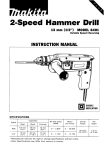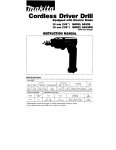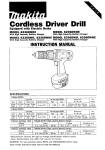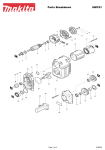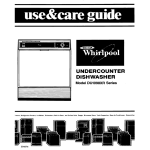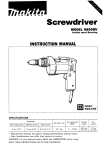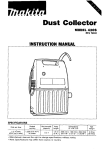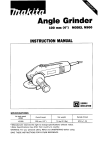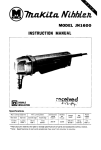Download Makita 4303C Instruction manual
Transcript
Electronic Jig Saw MODEL 4303C INSTRUCTION MANUAL SPECIFICATIONS Max. cutting capacities Length of stroke 26 mm (1") Wood 1 'Omm (2.318") Strokes I I!$: Overall length per minute Steel 1 1,000 - 3,000 I 2 19mm (8-518") Manufacturer reserves the right to change specifications w i t h o u t notice. Note: Specifications may differ from country t o country. WARNING: For your personal safety, READ and UNDERSTAND before using. SAVE THESE INSTRUCTIONS FOR FUTURE REFERENCE. I 1 weight Net 2.5 kg (5.5 Ibs) IMPORTANT SAFETY INSTRUCTIONS (For All Tools) WARNING: WHEN USING ELECTRIC TOOLS, BASIC SAFETY PRECAUTIONS SHOULD ALWAYS BE FOLLOWED TO REDUCE THE RISK OF FIRE, ELECTRIC SHOCK, AND PERSONAL INJURY, INCLUDING THE FOLLOWING: READ ALL INSTRUCTIONS. 1. KEEP WORK AREA CLEAN. Cluttered areas and benches invite injuries. 2. CONSIDER WORK AREA ENVIRONMENT. Don't use power tools in damp or wet locations. Keep work area well lit. Don't expose power tools t o rain. Don't use tool in presence of flammable liquids or gases. 3. KEEP CHILDREN AWAY. All visitors should be kept away from work area. Don't let visitors contact tool or extension cord. 4.STORE IDLE TOOLS. When not in use, tools should be stored in dry, and high or locked-up place - out of reach of children. 5 . DON'T FORCE TOOL. It will do the job better and safer at the rate for which it was intended. 6. USE RIGHT TOOL. Don't force small tool or attachment t o do the job of a heavy-duty tool. Don't use tool for purpose not intended; for example, don't use circular saw for cutting tree limbs or logs. 7 . DRESS PROPERLY. Don't wear loose clothing or jewelry. They can be caught in moving parts. Rubber gloves and non-skid footwear are recommended when working outdoors. Wear protective hair covering t o contain long hair. 8. USE SAFETY GLASSES. Also use face or dust mask i f cutting operation is dusty. 9. DON'T ABUSE CORD. Never carry tool by cord or yank it t o disconnect from receptacle. Keep cord from heat, oil, and sharp edges. 10. SECURE WORK. Use clamps or a vise t o hold work. It's safer than using your hand and it frees both hands t o operate tool. 11. DON'T OVERREACH. Keep proper footing and balance at all times. 12. MAINTAIN TOOLS WITH CARE. Keep tools sharp and clean for better and safer performance. Follow instructions for lubricating and changing accessories. Inspect tool cords periodically and if damaged, have repaired by authorized service facility. Inspect extension cords periodically and replace if damaged. Keep handles dry, clean, and free from oil and grease. 13. DISCONNECT TOOLS. When not in use, before servicing, and when changing accessories, such as blades, bits, cutters. 2 14. REMOVE ADJUSTING KEYS AND WRENCHES. Form habit of checking t o see that keys and adjusting wrenches are removed from tool before turning it on. 15. AVOID UNINTENTIONAL STARTING. Don’t carry tool with finger on switch. Be sure s w i t c h is OFF when plugging in. 16. EXTENSION CORDS. Make sure your extension cord is in good condition. When using an extension cord, be sure t o use one heavy enough t o carry the current your product will draw. A n undersized cord will cause a drop i n line voltage resulting in loss of power and overheating. Table 1 shows the correct size t o use depending on cord length and nameplate ampere rating. If in doubt, use the next heavier gage. The smaller the gage number, the heavier the cord. TABLE 1 MINIMUM GAGE FOR CORD SETS Total Length of Cord in Feet 0 - 25 26 - 50 Ampere Rating More Not More Than Than 0 6 10 12 - 6 10 12 16 51 - 100 101 - 150 AWG 18 18 16 14 16 16 16 12 : I 14 12 14 12 Not Recommended 3 VOLTAGE WARNING: Before connecting the tool to a power source (receptacle, outlet, etc.) be sure the voltage supplied is the same as that specified on the nameplate of the tool. A power source with voltage greater than that specified for the tool can result in SERIOUS INJURY to the user - as well as damage to the tool. If in doubt, DO NOT PLUG IN THE TOOL. Using a power source with voltage less than .the nameplate rating is harmful to the motor. ADDITIONAL SAFETY RULES 1. Avoid cutting nails. Inspect for and remove all nails from the workpiece before operation. 2. Don't cut hollow pipe. 3. Do not cut oversize workpiece. 4. Check for the proper clearance beneath the workpiece before cutting so that the blade will not strike the floor, workbench, etc. 5. Hold the tool firmly. 6. Make sure the blade is not contacting the workpiece before the switch is turned on. 7. Keep hands away from moving parts. 8. When cutting through walls, floors or wherever "live" electrical wires may be encountered, DO NOT TOUCH ANY METAL PARTS OF THE TOOL! Hold the tool only by the insulated grasping surfaces to prevent electric shock if you cut through a "live" wire. 9. Do not leave the tool running. Operate the tool only when hand-held. IO. Always switch off and wait for the blade to come to a complete stop before removing the blade from the workpiece. 11. Do not touch the blade or the workpiece immediately after operation; they may be extremely hot and could burn your skin. SAVE THESE INSTRUCTIONS. 4 Installing Makita jig saw blade CAUTION : Always be sure that the tool is switched off and unplugged before installing or removing the blade. Use the hex wrench to loosen the bolt. With the blade teeth facing forward, insert the blade into the blade holder as far as it will go. Make sure that the back edge of the blade fits into the roller and tighten the bolt securely with the hex wrench. I * Jig saw blade CAUTION : Use a lubricant or cutting oil between the blade and roller when cutting iron or composition board, etc. Failure to do so will shorten the service life of your blade and roller. 5 Installing universal shank jig saw blade CAUTION : Always be sure that the tool is switched off and unplugged before installing or removing the blade. If the universal blade clamp i s used, you can use blades of other makes which have a universal shank like the one shown in the figure, with a blade width of 6.35 mm (1/4"). Insert the blade into the blade holder as far as it will go. Make sure that the end of the blade shank reaches the bottom of the inner s l i t and tighten the bolt securely with The end of the blade shank should reach the bottom of the inner slit the hex wrench. il 6 Straight line or orbital cutting action Conventional jig saws cut with a straight line action, that is, the blade moves only up and down in a straight line. Your saw also cuts in this manner but, for softer workpieces, an orbital cutting action can be selected. Soft workpieces like wood and plastic permit deep penetration of individual saw teeth. The orbital action thrusts the blade forward on the cutting stroke and greatly increases cutting speed over conventional jig saws. Harder workpieces like metal should be cut using the straight line cutting action or a very low orbital setting. To select straight line or orbital cutting, adjust the number on the saw. I \ Lever Position 0 - For cutting in mild steel, stainless steel and plastics. For clean cuts in wood and plywood. Position I - For cutting in mild steel, aluminum and hard wood. Position I1 - Position I11 - For cutting in wood and plywood. For fast cutting in aluminum and mild steel. For fast cutting in wood and plywood. Switch action To start the tool, simply pull the trigger. Release the trigger to stop. For continuous operation, pull the trigger and then push in the lock button. To stop the tool from the locked position, pull the trigger fully, then release it. Lock button / Switch triqqer CAUTION : Before plugging in the tool, always check to see that the switch trigger actuates properly and returns to the "OFF" position released. Speed change To adjust the tool speed, turn the speed change dial. The tool speed can be adjusted between 1,000 and 3,000 strokes per minute. The reference table on the right denotes the relationship between the number settings on the speed change dial and the approximate strokes per minute a t that setting. Number 1,000 2 1,200 I 1,700 1 I 3 1 1 4 2,200 1 1 5 2,700 I 3,000 I 6 Refer to the table on the right to select suggested speed for the workpiece to be cut. However, proper speed may differ depending upon the type or thickness of the workpiece. Strokes per minute 1 Wor kpiece Wood M i l d steel Stainless steel Aluminum Plastics I I I Number 5-6 3-6 3-4 2-3 1-4 In general, higher speeds will allow you to cut a workpiece faster but the service life of the blade will be reduced. CAUTION : Adjust the speed change dial only within the range of numbers 1 through 6. Do not force the dial beyond this range. 8 Operation Turn the tool on and wait until the blade attains full speed. Then rest the base flat on the workpiece and gently move the tool forward along the previously marked cutting line. When cutting curves, advance the tool very slowly. I . I CAUTION : Failure to hold the tool base flush with the workpiece may cause blade breakage. Bevel cutting With the base tilted, you can make bevel cuts a t any angle between 0" and 45" (left or right). Loosen the bolt on the back of the base with the hex wrench and slide the base backwards. Tilt the base to the desired angle. The edge of the housing indicates the bevel angle. Then check the contact between the back edge of the blade and the roller. Now tighten the bolt securely on the back of the base. Edge of housing 9 Front flush cuts Loosen the bolt on the back of the base with the hex wrench, then slide the base backwards. Check the contact between the back edge of the blade and the roller, then secure the bolt. Plunge cutting Starting a cut a t other than the edge of the workpiece without first drilling a starting hole requires a "plunge cut". This can be accomplished by tipping the tool forward until the front end of the base rests against the workpiece. Switch the tool on and lower the back end of the tool slowly, gradually allowing the blade to saw through the workpiece until the base i s able to s i t flat on the workpiece. You may then proceed forward with the cut in a normal manner. If using a drill for a starting hole, bore a hole over 12 mm (1/2") in diameter. Then insert the blade in it and proceed. Finishing edges To trim edges or make dimensional adjustments run the blade lightly along the cut edges. For smoother cutting of plywood or other workpieces with easily splintered surfaces, transparent tape may be used over your cutting line. 10 I I Using guide rule (Rip fence) When cutting widths of under 150 m m (6") repeatedly, use of the guide rule will assure fast, clean, straight cuts. ~ To attach the guide rule (rip fence), secure the rule holder to the base with the screw (do not tighten). Insert the guide rule between the base and the rule holder. Now tighten the screw with the hex wrench. I Rule holder Guide rule Screw Hex wrench Using circular guide Use of the circular guide insures clean, smooth cutting of circles (radius; under 200 m m ; 7-7/8")and arcs. I Circular guide 11 To attach the circular guide, use the pin, inserting it in the center hole (arrow) and secure it with the threaded knob. Then slide the base of the tool forwards. The circular guide attaches to the base of the tool in the same manner as the guide rule (rip fence). 0I Knob F i t pin into this hole b Pin for circular guide Metal cutting Always use a suitable coolant (cutting oil) when cutting metal. Failure to do so will cause significant blade wear. I Cutting oil The underside of the workpiece can be greased instead of using a coolant. 12 MAINTENANCE CAUTION: Always be sure that the tool is switched off and unplugged before attempting to perform inspection or maintenance. To maintain product SAFETY and RELIABILITY, repairs, carbon brush inspection and replacement, any other maintenance or adjustment should be performed by Makita Authorized or Factory Service Centers, always using Makita replacement parts. ACC ESSOR I ES CAUTION: These accessories o r attachments are recommended f o r use w i t h y o u r Makita tool specified in this manual. The use of any other accessories o r attachments m i g h t present a risk o f injury to persons. The accessories o r attachments should be used o n l y in the proper and intended manner. A n exception: Universal shank jig saw blades w i t h a thickness of 1 mm - 1.25mm (1/32"- 3/64") and a length o f 58 mm - 82 mm (2-9/32" - 3-7/32"). 0 Circular guide assembly Part No. 123030-5 Hex wrench 3 Part No. 783201-2 s Jig saw blade (Packed 5 each) 0 Guide rule (Rip fence) Part No. 1641 13-2 - (Note) Refer to the next page for "Application" of each blade. 13 Jig saw blade Application No. 51 I Plastics Aluminum Mild steel 1.5 - 3 mm thick 11/16’ - 1/8”) 1 - 6 mm thick 13/64” - 1/4‘l 3 mm thick 13/64’’ - 1/8”l 4 - 30 mm thick I For fast cutting. 4 - 30 mm thick 15/32’’ - 1-1/8“) For fast finish work. No. 6-13 No. 6-14 I I 8-15 No. 6-16 - I For fast finish work. I I I I H I I 5 - 60 mm thick (13/64“ - 2-3/8”) I 4 - 60 mm thick 15/32” - 2-3/8‘) 4 - 60 mm thick 15/32” - 2-3/8”1 2 - 30 mm thick 15/64‘’ - 1-1/8”1 2 - 30 mm thick 15/64‘’ - 1-1/8”) U - l-l/8”) 5 - 60 mm thick l13/64“ - 2-3/8”) 3 - 30 mm thick 11/8‘ - 1-1/8”) 9 Y q z15/64” F K - 1-1/8”) x r No. For fast finish work. 2-3/8”) ( 13/64” - 2-3/8“) 6-19 3 - 30 mm thick 11/8“ - l - l / 8 ” ) No. No. 8-27 3 - 30 mm thick 11/8” - 1-1/8”) H 3 - 55 mm thick (1/8” - 2-1/8”) I I - 3 - 10 mm thick 1118‘’ - 318”) I I I Cuts on down stroke. Splinter-free on finish side. I For finish work, especially in plastics 1 - 6 mm thick (3164‘’ - 114“) 1 - 3 mm thick 3 - 10 mm thick (1/8” - 3/8”l 3 - 6 mm thick ( 1 /8” - 1/4”) Also ideal for cutting stainless steel. 0.5 - 2 mm thick 11/64” - 5/64”) Also ideal for cutting stainless steel. 0.5 - 3 mm thick 11/64“ - 1/8”) 13/64” I - 1/8”) - 10 mm thick 11/8” - 3/8”) 3 - 55 mm thick 11/8” - 2-1/8”) 3 - 55 mm thick (1/8“ - 2-1/8”) Also ideal for cutting stainless steel. 3 - 30 mm thick 11/8” - l - l / 8 ” ) 3 3 - 30 mm thick 1118’’ - 1-118”) 3 - 10 mm thick 11/8” - 3/8”) Ideal for scroll cutting 1 - 3 mm thick 13/64” - 118”) Ideal for scroll cutting. H Ideal for cutting thick materials. H - 1.5 - 3 mm thick 11/16’’ - 118”) NOTE: ”H” s t a n d s for h a r d m a t e r i a l s ”S” s t a n d s for s o f t m a t e r i a l s 14 For fast cutting. Ideal for scroll cutting - 3 mm thick 13/64’ - 118”) H I 1 - 2 - 30 mm thick 15/64” - 1-1/8”) 1 No. Ideal for cutting thin materials. Ideal for scroll cutting. 3 - 6 mm thick (118’’ - 1/4”) 6-26 I 1.5 - 3 mm thick 11/16’’ - 1/8”) 3 - 55 mm thick For roughing-in work Ideal for cutting thin materials. H I - 5 - 60 mm thick (13/64” - 2-3/8”) 3 - 55 mm thick 11/8” - 2-1/8”) 6-22 For fast finish work, especially in plywood - 3 - 30 mm thick l1/8” - 1-1/8”1 11/8” I - S 113/64” Feature Also ideal for cutting stainless steel. 4 - 60 mm thick 15/32’’ - 2-3/8”) 3 - 60 mm thick ll/8” - 2-318”) No. - H 4 - 60 mm thick 8-11 1 U 1 - 6 mm thick 13/64” - 114”) May-19--'94 US ELECTRONIC JIG SAW Model 4303C Note: The switch and other part configurations may differ from country to country. 15 MODEL 4303C May-19-'94 ZDDESCRIPTION E= ITEM NO NO USED US IKSCRIPTION MA1 ~ 1 1 41 2 1 42 3 1 1 43 4 5 6 1 1 4 7 8 9 0 1 1 11 2 3 44 45 46 47 48 49 50 51 52 14 18 1 53 51 3 55 19 1 56 20 1 1 1 21 22 23 24 1 1 1 1 25 26 2, 28 29 57 58 59 60 61 62 63 64 55 66 30 31 32 33 67 1 1 66 Pan Head Screw MSr2S lWllh Warherl Hourlng se, lWlth ,,em 2, Rvbbsr P," 4 Retalnlng Ring s 6 e" 4 Relamel Roller sponge Sheet 69 D"3, mate stop Ring E 70 P," 5 34 72 Cord 35 75 75 79 80 Carbon Brush 36 31 38 3 BWSh Holder ControllFr Proteclo, 39 40 - MAKITA LIMITEDONE YEAR WARRANTY Warranty Policy I very Uakttd tool is thoroughly mspected and tasted before leaving the factory I t IS warranted to bc free of detects trom workmanship and matenalr tor the penod of ON1 Y I AR from the date ot ongnal purthax Shuuld any trouble develop dunng this une-year penod. return the (OMPLFTI tool. freight prepaid. to one of Maktta's F d ~ t o r yor Authorized S ~ N I CCenter, C If inspection shows the trouble IS Laused by defective uorkmanship or matenal. hlakita wdl repair (ur dl our option. replace) without charge . This Warranty does not apply where: repairs have been made or attempted by others: repairs are required because of normal wear and tear: The tool has been abused, misused or improperly maintained; alterations have been made to the tool. IN NO EVENT SHALL MAKITA BE LIABLE FOR ANY INDIRECT, INCIDENTAL OR CONSEQUENTIAL DAMAGES FROM THE SALE OR USE O F THE PRODUCT. THIS DISCLAIMER APPLIES BOTH DURING AND AFTER THE TERM O F THIS WARRANTY. MAKITA DISCLAIMS LIABILITY FOR ANY IMPLIED WARRANTIES, INCLUDING IMPLIED WARRANTIES O F "MERCHANTABILITY" AND "FITNESS FOR A SPECIFIC PURPOSE," AFTER THE ONE-YEAR TERM OF THIS WARRANTY. This Warranty gives you specific legal rights, and you may also have other rights which vary from state to state. Some states do not allow the exclusion or Limitation of incidental or consequential damages, so the above limitation or exclusion may not apply to you, Some states do not allow limitation on how long an implied warranty lasts, so the above limitation may not apply to you. Makita Corporation 3-11-8, Sumiyoshi-cho, Anjo, Aichi 446 Japan 883885 - 069 PRINTED IN JAPAN 1994 - 6 - N

















